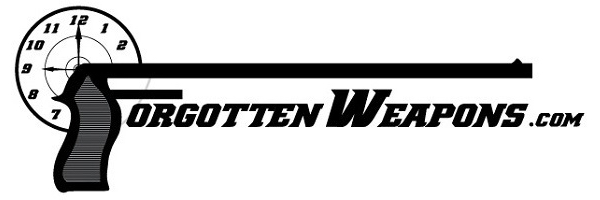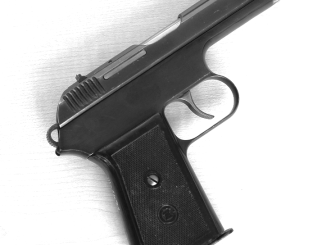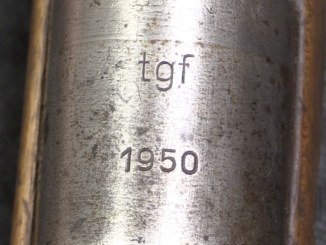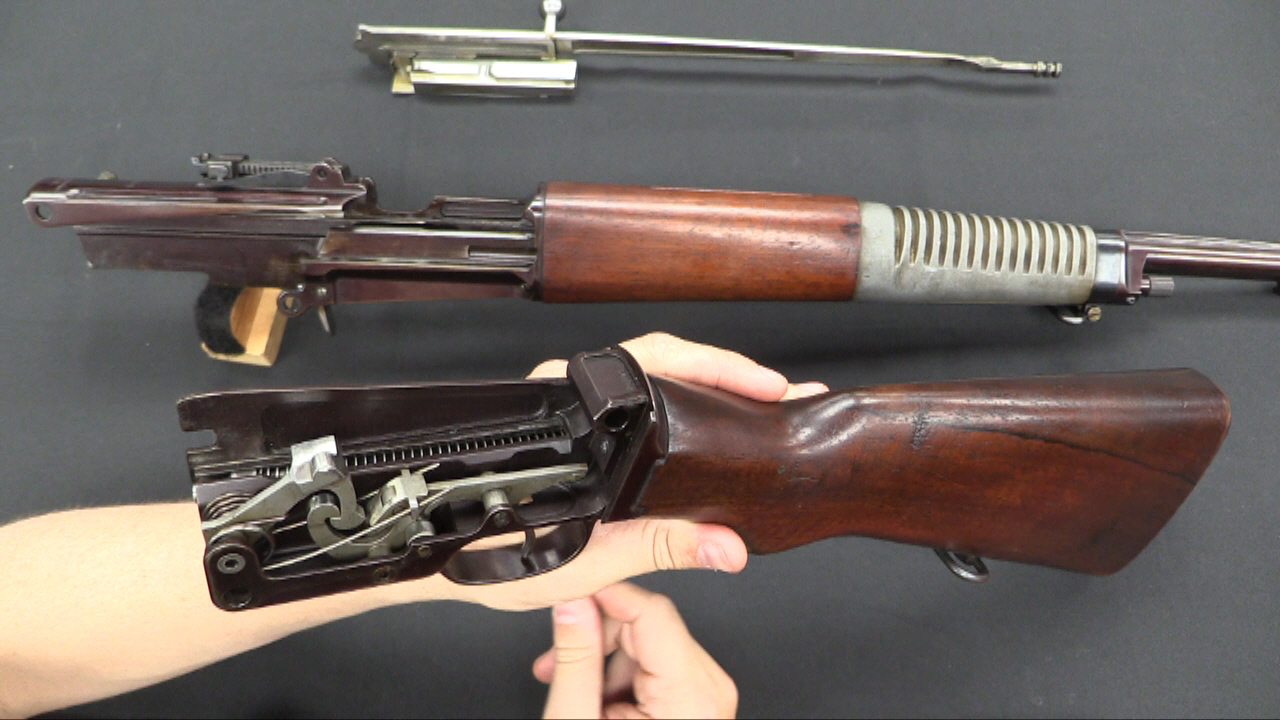The URZ (Univerzální Ruční Zbraň, or Universal Hand Weapon) was a 1966 project designed by Jiří Čermák (designer of the vz.58 rifle). He envisioned a weapons system family with largely interchangeable elements that could be configured as a service rifle, carbine, light machine gun, vehicular machine gun, or precision rifle. The Czech military was not interested, but Čermák was able to convince the government to allow its development for export instead.
The design is a delayed-blowback system using rollers, and belt-fed. The first few examples were made in 7.62x39mm, but development switched to 7.62x51mm NATO in a rather surprising move. Presumably this was intended for sale to unaligned nations who were interested in the NATO cartridge, but still – seeing its development in then-communist Czechoslovakia is pretty unusual. Ultimately only 9 examples were built before the project was abandoned.
Thanks to the Czech Military History Institute (VHU) for graciously giving me access to this one-of-a-kind prototype to film for you! If you have the opportunity, don’t miss seeing their museums in Prague:
https://www.vhu.cz/en/english-summary/




“(…)development in then-communist Czechoslovakia is pretty unusual(…)”
Not only they did that, Novotny managed to get British patent for Improvements in and relating to a magazine for automatic firearms https://patents.google.com/patent/GB1209542A
Thank you very much, Ian, for your contribution and for introducing us to this weapon with its unusual semi-rigid roller lock. The system is actually not directly comparable to the lock invented by Mauser at the end of World War II (Gerät 06H) and then used by HK in the G3 and MP5.
Incidentally, Cermak filed a patent for his breech mechanism in the US at the end of October 1968 (US3,407,702). The documents will certainly be of interest to some of you.
I love this thing! This is classic Forgotten Weapons content! I think Mr. M’Collum and most respondents are familiar with my gushing fan posts, but allow me to state that you’ll see hazy photos and a brief description of this weapon from dated firearm books and say: “Huh! That’s an interesting idea…! I wonder how that worked, exactly?” And now, thanks to our intrepid Ian, we get to see it up close and in working order. Simply fascinating. I’d go to Prague for the beer but dang if it hasn’t gone up on my “bucket list” to see these types of museums and collections too! Bravo! This URZ is very interesting.
[OFF-TOPIC so ignore if you wish]
Sülün Arms is offering such shotgun https://sulunarms.com/st-601/
Some article claim it is aimed at Australian market as it would fit inside Category A which holds shotgun excluding self-loading, pump-action and lever-action. This seems plausible, but question: what action is this?
That looks like an updated variant if the Alofs.
https://m.youtube.com/watch?v=hNIkca8k1UQ&pp=0gcJCdgAo7VqN5tD
It looks even more like a shotgun version of the Civil War Triplett & Scott carbine.
https://www.americanrifleman.org/content/triplett-scott-arms-of-kentucky/
Other than the magazine being external on the left side instead of being inside the stock, the principle is fundamentally the same.
Of course, no multiplicity of examples can necessarily make something a good idea.
clear ether
eon
So… what action it actually is?
I think from the mag tube cartridge/shell slides in that separate holder, that you rotate and then push in manually the cartridge from holder to chamber. Maybe the anti-gun idea was to make manual loading even more cumbersome and slow !?
nice find btw.
I still am confused to what action it actually is, but anyway it seems to allow quick cycling, see https://www.youtube.com/watch?v=QPzXqPwNWh4
It was basically on the same principle as the Stoner 63 weapon system developed in the U.S. at around the same time. And like the Stoner ran into the caliber problem.
The Stoner made very good sense as an individual weapon, in fact there is at least one commercial semi-automatic version of it on the market today. It was a usable SAW within the limits of the 5.56x45mm cartridge.
Where the Stoner fell down was that the 5.56x45mm just was not (and still is not) a heavy enough round for either a support MG (on tripod) or vehicle MG (as in tank coax or IFV turret mount). Bot roles require more range and power than the 5.56 round has, no matter how much you fiddle with bullet weights and etc.
The URZ, by comparison, made excellent sense as either a tripod-mounted support MG or a vehicle-mounted coax, both ideally belt-fed. You could even make a case for it in the SAW role. Where it fell down was as an individual rifle; 7.62x51mm is just too much cartridge for that job, always has been, and always will be. And I speak as someone who’s put in some serious range time with M14s and Garands.
My affection for the M1 Carbine was earned by that logically-designed little PDW at a time when “conventional wisdom” from the Korean war was that it was a useless “popgun” firing a pipsqueak round. In many ways, the criticism of the carbine in Korea paralleled that of the M16 in Vietnam a decade later. Both were in fact optimized for CQB within 150 meters. Once that was understood and applied, they got the job done properly.
URZ would probably have fared better if it had been developed solely as a support/coax MG. Even the Warsaw Pact armies tacitly admitted that 7.62x51mm was a better round for that kind of work than 7.62x54Rmm could ever be, just on the grounds of simpler and more reliable feed mechanism geometry.
With URZ as the MG backing up Vz58 as the IW, the Czech army would have had a pretty serious combination- and one not beholden to Moscow.
clear ether
eon
It’s the classic problem with regards to the whole “One Cartridge to Rule Them All” idea. You simply cannot make it work, due to the vastly different roles and requirements for the two classes of weapons, individual and support.
With current materials technology and everything else involved, that is simply a delusional pipe dream that the idealistic wonks keep trying to make work. They remind me of that kid I knew, whose parents thought he was an absolute genius because he kept hammering away at his “match-the-block” toy, until he managed to drive the square peg into the round hole. I mean, he eventually got it in, but… The toy was broken.
The “square the circle” idea is nice, but it’s mathematically impossible as far as we know. Why they keep trying with the singular cartridge solution, I’ll never know; it’s not like we don’t already have to provide multiple ammo formats anyway, based on feed mechanisms. How hard is it to have “Beeger Boolets” in belts for the support systems, and smaller ones for the individual weapons? It’s a fallacy that it’d make life easier; the reality is that you either wind up with a too-heavy individual weapon cartridge, or a too-wimpy support weapon cartridge. There is no happy medium, here. But, the various idjits keep trying for one, despite ample evidence from real life that such things don’t work worth spit.
I could see a belt-fed support weapon in an individual weapon cartridge being workable if you were in an environment that restricted your fires such that you didn’t need to worry about a lot of the effects downrange past about 400m. Say, really constricted jungle or urban, but even in those environments, the “punch” of a true support weapon cartridge is going to have value.
In the past, the Soviets opted for a optimized individual weapon cartridge. They had to abandon that, and revive the big gun 7.62X54R PK, in order to get the job done. The United States, in its wisdom, optimized for the support role (perhaps unconsciously…) and wound up having to go to a smaller individual weapon caliber in the 5.56X45 cartridge put into the M16. Not being capable of learning from that, they recapitulated the process, and procured the NGSW.
Which has me wondering if they don’t have something of an Elbonian situation going on, what with JCS Milley being a Chinese pawn. From what I understand, he was the moving force behind NGSW going the way it did and the eventual procurement of the systems that resulted, which I suspect could well argue that enemies of the United States were involved in the decision-making process. That would kind of make sense, because the whole NGSW program is just nuts, when you look at where it began and where it wound up. They were supposed to drastically lighten the load for the soldier; they actually increased it, and made the weapons far less effective at what they should be doing for their roles. I mean… OK, the M7 is now this huge DMR-like thing that isn’t going to be doing very well during the close-in battle where you need rifles that are small and light enough to do skeet-shooting with, and the idiots didn’t even really pay attention to the whole “support weapons only effective at range with tripod” issue for the M250. They’re still putting that thing on top of the old M122/192 disaster, and I’ve heard rumors from folks that the crews usually don’t even have those, because the idea is that the M250 is filling the M249 role, not the M240 one. Which is, frankly, a bit nuts.
The whole thing is insane. If you bother to look, there’s ample historical evidence that the “one cartridge/all roles” idea doesn’t work, but like a dog to its vomit, here we go again…
“(…)revive the big gun 7.62X54R PK(…)”
What definition of revive are you using?
“(…)Even the Warsaw Pact armies tacitly admitted that 7.62x51mm was a better round for that kind of work than 7.62x54Rmm could ever be(…)”
Source?
“(…)With URZ as the MG backing up Vz58 as the IW, the Czech army would have had a pretty serious combination- and one not beholden to Moscow.(…)”
I do not know what IW is, though I think it should be pointed that ČSLA already had domestic machine gun in form of https://modernfirearms.net/en/machineguns/czech-republic-machineguns/vz-59-uk-vz-59-eng/
IW= Individual Weapon.
Vz59 was still hampered by being in 7.62x54Rmm. The UK68 version in 7.62x51mm made more sense.
The rimmed cartridge had a good run but after about 1950, it should have been “gone” except for revolvers, sporting shotguns and some varieties of sporting rifles. It had no further reason to be in any military arm.
The rimless cartridge should have been the world standard by that time, and as long as we’re using metal-cased cartridges it still should be. Pardon me if I consider the “belted” cartridge a case of neither fish, nor fowl, or anything but a design nearly as aggravating to work around as the rimmed cartridge.
clear ether
eon
On the other hand, the Soviets made a virtue of the “obsolescent” rimmed cartridge, and that’s why the PK series is able to have such a short receiver.
The rim can be made to work to your advantage, if you’re sufficiently open-minded. I’d love to see the actual paperwork on Soviet/Russian thought, when it came to retaining the 7.62X54R cartridge in service, but I’ll bet money that at least a part of it all came down to the Kalishnikov design bureau saying to themselves “Yeah, we’re gonna have to keep this damn thing, might as well make a virtue of it…”
Somewhere, I’ve read a intel report on Soviet modernization, where they discuss the decision to keep the 7.62X54R. The analyst who wrote it seemed to believe that it was an “installed base” thing, and that they had all this production machinery set up and running, soooooo… There were, supposedly, programs to create a modernized cartridge, but so long as they could make 7.62X54R work, nobody wanted to spend the money and suffer through the transitional effects.
It is an oddity, for sure; that case was designed back in the days of black powder, and was meant for a single-shot weapon. The fact that it served from then until now makes it a virtual Coelacanth of cartridge design; nothing else of its era is still in widespread use for military purposes. It’s like someone built the M60 in .45-70, or something equally insane.
The PK series of machineguns just works, which is a bit of a wonder when you think about it. I’d do very little to “improve” them, first and foremost being the barrel-locking mechanism. The way it was implemented on the Soviet versions is just plain “You’re gonna burn your fingers off…” silly. Still not too sure what the design decisions were behind that one…
Mikhail T. Kalashnikov himself was requested to develop new machine gun for rifle-cartridge after Nikitin-Sokolov proposal was already beyond state trials. As he himself call it, he was supposed to be knout to make designer of mentioned machine remove defects in timely manner
https://militera.lib.ru/memo/russian/kalashnikov_mt/09.html
Considering above it should be not surprise that decision was made to use already existing solutions w.r.t. barrel change, which show great similarity to one used inside SGM machine gun.
@Daweo,
It isn’t that I distrust your sources, but that there are several (supposedly) reliable sources that describe the whole Kalishnikov/Nikitin thing very differently. The accounts that I’ve read all describe Kalishnikov being insulted by the exclusion of his design bureau from the new machinegun competition, and then “doing his own” and pushing it into the competition through his contacts.
It’s hard to work out the reality, whenever you start digging into Soviet history. The participants all tell different stories, and the records were never actually made public.
The interesting thing in the piece you link to is how little background there is given on who made the decisions in “feature priority” and who drove the train on things like sticking with the 7.62X54R. You also detect a strong whiff of “cult of personality” in the sense that the various heads of branches were able to influence things the way they wanted; it’s almost the same sort of BS you’d find in the Nazi “Fuhrerprinzip” craziness.
Not that American decision-making is really any different; witness the idiocy that is NGSW. We still don’t know a lot about the background details on that whole thing, and why it went from “lighten the load” to “Penetrate All the Things”. I’d love to see the classified files on the statements of need, and all the rest. I don’t doubt but that there was someone in the background, putting a thumb on the scales. Just like with the Unified Camouflage Pattern insanity… Sweet Jesus, but they had already paid for the development of MultiCam, all they had to do was pay the licensing fee. And, from the fact that we eventually went to that not-MultiCam that is functionally identical, we know that it worked. Already.
Morons. All of them. I still remember seeing the first UCP stuff, and thinking it was a practical joke that the guys down at Tactical Tailor were playing on me. But, it wasn’t…
The British went through a similar process in the 1920s.
https://www.cartridgecollector.net/cartridge/303-magnum-rimless/
Any 0.303in Enfield-chambered rifle or MG could be recalibered to this one by simply recutting the chamber. Giving the British a round ballistically similar to the original rimmed 0.303in Cordite (or the later 7.62x51mm, for that matter) that was a much better “feeder” through self-loading actions and bolt-actions both.
But except for Match shooting, the Army said “No thank you very much”.
I’ve often wondered if they noted the irony two decades later, in arming their armoured cars with Besa HMGs in 7.9x57mm; the German round. Besa did not “like” rimmed cartridges, but it was the only air-cooled HMG available.
As messed-up as U.S. Ordnance cartridge policy was at the time (“.276 is nice, but we only use .30-06”), we were still not in nearly as much of a muddle as the British, French, Japanese, etc.
clear ether
eon
@eon,
As an aside that I think you might appreciate, I think I just figured out the inspiration for S.M. Stirling’s fictional Holbars T-6 Assault Rifle, from his Draka oeuvre. It’s this weapon, clear as day. Stirling describes the T-6 as having a belt-fed drum magazine, and it puzzled me at the time I read the books that such a design would ever even be a “thing”. When Ian showed this, something tripped a memory that I couldn’t place, and I was thinking “Where the hell have I heard of this, before…?”
Now, I want to know if Stirling had this weapon in mind, or if he just flung some poo on the wall and got it partially “right”…
Could be. But Stoner 63 had the same setup on its LMG version;
https://nationalinterest.org/wp-content/uploads/2021/07/Clipboard-2021-07-26T172140.143.jpg
Both seem to have been inspired by the German MG34 “saddle drum”;
https://www.bergflak.com/PT34.htm
There was also a “one-side-only version” MG34 drum magazine. Of course the MG 34 magazines did not use a belt inside.
Belt or not, drum magazines seem to be one of those ideas people either love or hate. There seems to be no middle ground.
https://www.forgottenweapons.com/why-drum-magazines-are-a-bad-idea/
cheers
eon
Carbine in.. 256 Winchester Magnum. Small numbers were converted, it seems, creating another high-velocity round weapon on the M-1 Carbine design.
I’m more interested in this belt feed than I am the delayed blowback. It’s simple enough for it to be incorporated into the “drum” magazine, at the cost of having a really fat magazine. Consider what a belt-fed weapon costs on the civilian market today.
If you want to see drawing for said device then see https://patents.google.com/patent/US3456553A
So a Czech Stoner 63